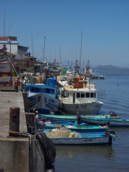Puntarenas
Puntarenas | |
|---|---|
City and municipality | |
|
Images, from top down, left to right: the Port Laborer Monument, Tourists Pass Avenue, The Cathedral within Central Park, Crown Princess docked at Puntarenas' Port, docked fishing boats, Puntarenas Pier. | |
| Nickname(s): La perla del Pacífico (Spanish) "The Pacific Pearl" | |
 Puntarenas and surrounding area | |
| Country | Costa Rica |
| Province | Puntarenas |
| Canton | Puntarenas |
| Incorporated | 17 September 1858 |
| Government | |
| • Type | Municipality |
| • Mayor | Rafael Ángel Rodríguez Castro (PLN) |
| Area | |
| • Total | 34.34 km2 (13.26 sq mi) |
| • Land | 30 km2 (10 sq mi) |
| • Water | 60 km2 (25 sq mi) |
| Elevation | 5 m (16 ft) |
| Population (2012) | |
| • Total | 34,085 |
| • Density | 990/km2 (2,600/sq mi) |
| • Demonym | Puntarenense |
| Time zone | UTC-6 (Central) |
| Postal code | 60101 |
| Area code | + 506 |
| Website | http://www.puntarenas.go.cr/ Template:Es |
Puntarenas (Pointsands, from "punta arenas", or "sand point" in Spanish) is the capital and largest city in the Province of Puntarenas, on the Pacific coast of Costa Rica. The eponymous and oddly shaped province has its largest section in the South, far from the capital.
Overview
Some 100,000 live in the city and close towns.[citation needed] With beaches on the Pacific Ocean, it also attracts many tourists, especially surfers. It is also a possible stopover point for the tourist destination Monteverde, to the northwest.
Its port, Caldera, is one of the main ports in the country. Also, regularly scheduled ferries carry vehicles from Puntarenas to the Nicoya Peninsula.[1]
History
First known as Villa Bruselas in colonial times, Puntarenas was discovered by Hernán Ponce de León in 1519. Despite the use of the Gulf of Nicoya as an entryway to Costa Rica's inland territory, the port of Puntarenas was not developed until 1840 when coffee production in the highlands reached exportable volumes. In 1845 the Congress of the Republic declared Puntarenas a duty-free port (with the exception of Cognac and hard liquor). Originally, the coffee was brought to port in oxcarts via a trail through the mountains. In 1879, a stretch of railroad track was completed which connected Puntarenas with the town of Esparza (one of the country's earliest Spanish settlements, founded in 1554, a decade before the Central Valley began to be colonized) where the oxcart trail came out of the mountains. Eventually, the railroad was built all the way through to San José and service was inaugurated in 1910.
With the railroad connection to the Central Valley, the Pacific port's activities continued to be a major part of the region's economy throughout the 20th century. However, due to the aging and deterioration of the port facilities and the need to accommodate the much larger vessels of modern shipping fleets, a new port was constructed in the 1980s to the south of Puntarenas. The site chosen was Caldera (located at 9°54′39″N 84°43′10″W / 9.9108438°N 84.7194761°W), where ships had anchored during colonial times.
Sports
The city's major football teams are Second Division sides Puntarenas F.C., who have played many season at the highest level, and Jacó Rays.
Climate
Puntarenas is generally hotter than the Costa Rican Central Valley, with daytime highs ranging from 30°C to 35°C in the coldest/hottest months, respectively.[2]
| Climate data for Puntarenas | |||||||||||||
|---|---|---|---|---|---|---|---|---|---|---|---|---|---|
| Month | Jan | Feb | Mar | Apr | May | Jun | Jul | Aug | Sep | Oct | Nov | Dec | Year |
| Mean daily maximum °C (°F) | 33.5 (92.3) |
34.4 (93.9) |
34.0 (93.2) |
34.6 (94.3) |
33.1 (91.6) |
32.2 (90.0) |
32.2 (90.0) |
32.2 (90.0) |
31.9 (89.4) |
31.6 (88.9) |
31.8 (89.2) |
32.0 (89.6) |
32.8 (91.0) |
| Daily mean °C (°F) | 27.6 (81.7) |
28.3 (82.9) |
28.5 (83.3) |
29.2 (84.6) |
28.6 (83.5) |
27.9 (82.2) |
27.7 (81.9) |
27.7 (81.9) |
27.5 (81.5) |
27.4 (81.3) |
27.3 (81.1) |
27.1 (80.8) |
27.9 (82.2) |
| Mean daily minimum °C (°F) | 21.7 (71.1) |
22.2 (72.0) |
22.9 (73.2) |
23.7 (74.7) |
24.1 (75.4) |
23.6 (74.5) |
23.2 (73.8) |
23.1 (73.6) |
23.1 (73.6) |
23.2 (73.8) |
22.8 (73.0) |
22.1 (71.8) |
23.0 (73.4) |
| Average rainfall mm (inches) | 5.5 (0.22) |
4.1 (0.16) |
4.9 (0.19) |
30.3 (1.19) |
204.1 (8.04) |
217.3 (8.56) |
175.7 (6.92) |
223.1 (8.78) |
296.1 (11.66) |
279.1 (10.99) |
132.0 (5.20) |
27.7 (1.09) |
1,599.9 (63) |
| Average rainy days | 1.8 | 1.9 | 2.9 | 7.8 | 19.1 | 21.0 | 18.0 | 21.8 | 24.3 | 24.5 | 14.7 | 5.7 | 163.5 |
| Mean monthly sunshine hours | 263.5 | 254.3 | 282.1 | 255.0 | 201.5 | 156.0 | 164.3 | 170.5 | 159.0 | 167.4 | 183.0 | 232.5 | 2,489.1 |
| Source 1: World Meteorological Organization[3] | |||||||||||||
| Source 2: Hong Kong Observatory[4] | |||||||||||||
Gallery
-
Cathedral of Puntarenas
-
Sculpture on the beach of Puntarenas
References
- ^ Ferry information
- ^ Puntarenas temperatures from Climatezone.com
- ^ "Climate Information for Puntarenas". World Meteorological Organization. Retrieved 4 August 2012.
- ^ "Climatological Information for Puntarenas, Costa Rica". Hong Kong Observatory. Retrieved 4 August 2012.
External links
 Puntarenas travel guide from Wikivoyage
Puntarenas travel guide from Wikivoyage- Puntarenas Province website
- Puntarenas commercial website
- www.radiopuntarenas.net La Radio Digital de Puntarenas










